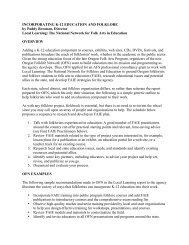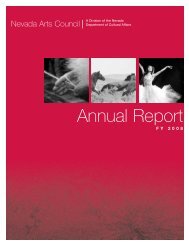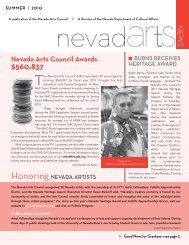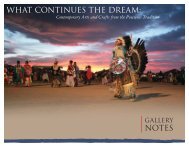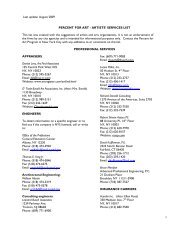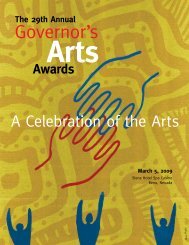Handed Down - Nevada Arts Council
Handed Down - Nevada Arts Council
Handed Down - Nevada Arts Council
You also want an ePaper? Increase the reach of your titles
YUMPU automatically turns print PDFs into web optimized ePapers that Google loves.
1996–1997<br />
Paiute Cradleboards:<br />
Ivie Garfield and Sharon Barton<br />
Achild living on the Ft. McDermitt Reservation in<br />
north central <strong>Nevada</strong> and raised from her earliest<br />
days in a willow cradleboard is already learning what it<br />
means to be Paiute. She is protected by the buckskin<br />
cover laced tight around her like a pair of sheltering<br />
arms; she is surrounded by the elements of nature like<br />
willow and hide that connect her to her place on the<br />
earth; and she is a part of the human community as she<br />
is carried where her parents go and propped up on a<br />
sofa or against a tree in the midst of adult activity. Both<br />
practically and symbolically, the cradleboard is central<br />
to Native American identity in the Great Basin.<br />
In her community of McDermitt, Ivie Garfield is acknowledged<br />
as a master maker of cradleboards. She has<br />
made them for all her children and grandchildren, as well<br />
as for many other people in the area. Her mother and<br />
grandmother were also artists in willow, and it was from<br />
them that Ivie learned. The first basket a newborn gets is<br />
boat shaped, and is used for about a month, traditionally<br />
a time when mother and child lived in a small dwelling<br />
outside the main house and saw no outsiders. Some<br />
women still maintain this practice by staying in a separate<br />
room in the house, and Ivie and her apprentice Sharon<br />
Barton agree that this is easier on both mother and child<br />
since they have few distractions. When the baby and<br />
mother return to the main house after a month, the child<br />
receives its full-size basket. It is made of small willow<br />
sticks woven together with split willow<br />
strings and attached to a long oval frame<br />
of heavy willow. The board is covered<br />
with a buckskin or canvas cover that<br />
laces up the front to hold the child in.<br />
At the top is a shade of very fine willows<br />
woven together and decorated with a<br />
pattern in yarn that tells whether the<br />
baby is a girl or a boy. The shade keeps<br />
light out of the baby’s eyes, it can protect<br />
the child should the board tip over,<br />
and a blanket can be draped over it when the baby sleeps.<br />
Both Ivie and Sharon, who is her niece, were born in<br />
McDermitt, which is a ranching community on the Oregon<br />
border. Ivie has lived there for all of her 77 years.<br />
During the apprenticeship they worked on identifying<br />
and gathering the proper willows, cleaning and splitting<br />
them, and weaving. Ivie also tans her own deer hides for<br />
the covers, something Sharon hasn’t taken on yet. One<br />
hide will cover one cradleboard, but Ivie has no set pattern<br />
she uses. Rather, she fits the particular hide to the<br />
frame, paying attention to the grain of the hide and the<br />
way it stretches. Ivie says she can remember every person<br />
she has made a cradleboard for; for the important<br />
part she plays in introducing children to their Paiute<br />
Heritage she is certain to be remembered as well.<br />
Ivie Garfield with some of her cradleboards.<br />
Ivie’s cradleboards<br />
Cradleboard frames hanging in a<br />
willow in Ivie’s yard.<br />
46




